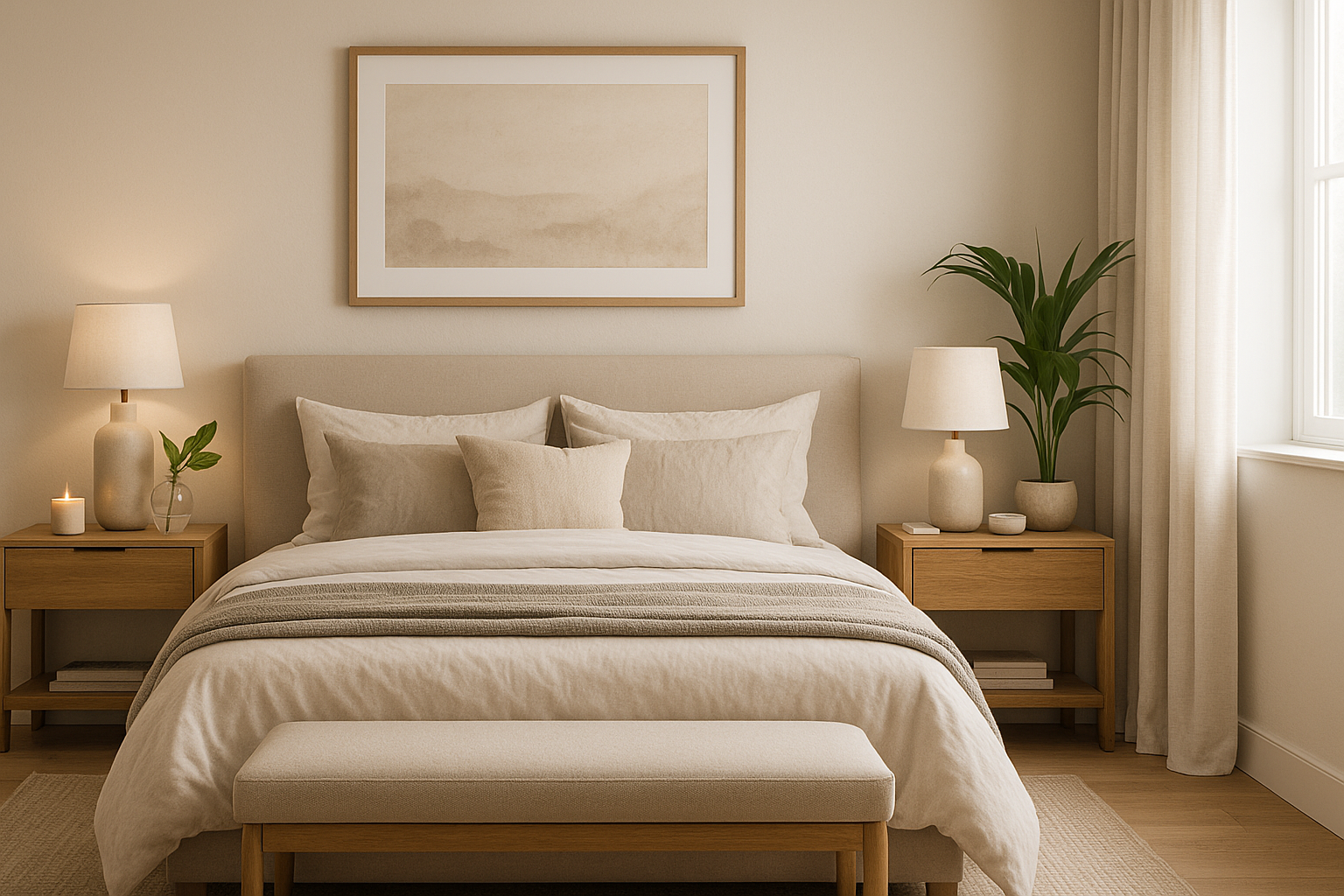Your bedroom is more than just a place to sleep — it’s your personal sanctuary, a space to recharge, reflect, and find peace. Yet, many people focus on decorating shared spaces like living rooms or kitchens while neglecting the bedroom. A well-decorated bedroom can dramatically improve not just your home’s aesthetic but also your sleep quality and emotional well-being.
Neste artigo, você vai aprender como transformar seu quarto em um refúgio de conforto e tranquilidade, combinando beleza, funcionalidade e harmonia.
Start with a Soothing Color Palette
Colors influence mood and sleep quality. Choose tones that promote relaxation.
- Soft neutrals like beige, ivory, and taupe create calm and warmth.
- Cool shades like pale blue, sage green, and lavender encourage serenity.
- Earth tones such as sand, clay, or soft browns bring a cozy, grounded feel.
- Avoid bright reds or neons, which can be overstimulating.
Your walls set the emotional tone for the entire room — keep them soft and subtle.
Invest in Quality Bedding
Comfort starts with what touches your skin.
- Use cotton, linen, or bamboo sheets for breathability.
- Choose high-thread-count bedding for a luxurious feel.
- Add a plush duvet or comforter layered with lightweight blankets.
- Mix two to three pillow types — firm, soft, and decorative.
Your bed should feel like a cloud — inviting you to rest instantly.
Optimize Lighting for Relaxation
Lighting can make or break the ambiance of a bedroom.
- Use warm light (2700K) to create a soft, restful glow.
- Add bedside lamps or wall sconces for reading.
- Install dimmers to control brightness at night.
- Incorporate blackout curtains to block outside light for deeper sleep.
Avoid harsh overhead lighting — aim for layers of soft, indirect light instead.
Choose the Right Furniture
Furniture should enhance comfort without crowding the space.
- Start with a comfortable bed frame — wooden for warmth or upholstered for softness.
- Use nightstands with storage for books, lamps, and essentials.
- Add a dresser or wardrobe with clean lines and minimal clutter.
- Include a bench or ottoman at the foot of the bed for practicality.
In small rooms, choose multi-functional furniture like under-bed drawers or wall-mounted shelves.
Keep Clutter Out of Sight
A peaceful mind begins in a tidy space.
- Store clothes and accessories neatly in closets or drawers.
- Use decorative baskets for small items like scarves or electronics.
- Keep surfaces clear — limit decor to one or two meaningful pieces.
- Adopt a “one in, one out” rule to maintain organization.
Visual calmness promotes emotional calmness.
Layer Textures for Depth and Comfort
Even neutral bedrooms can feel rich with the right textures.
- Mix linen sheets, wool throws, and velvet cushions.
- Use woven rugs for warmth underfoot.
- Add upholstered furniture or fabric headboards for softness.
- Combine smooth and rough materials for balance.
Texture brings tactile comfort and visual interest.
Add Personal and Meaningful Touches
Your bedroom should reflect who you are.
- Hang artwork or photography that evokes peace or joy.
- Display books or souvenirs on floating shelves.
- Use scents — candles, diffusers, or essential oils — to set a relaxing mood.
- Choose plants like lavender, snake plants, or peace lilies to purify air.
These details turn your room into a personal haven.
Create Zones for Function and Serenity
If space allows, divide your bedroom by activity.
- A reading corner with a chair and floor lamp encourages downtime.
- A small vanity or desk area adds function without clutter.
- Use rugs or screens to subtly define each zone.
- Keep entertainment devices like TVs minimal to avoid overstimulation.
Zoning helps balance relaxation and practicality.
Balance Symmetry and Flow
Symmetry promotes harmony and restfulness.
- Use matching lamps and nightstands on either side of the bed.
- Hang artwork centered above the headboard.
- Keep walking paths clear to create easy flow.
- Maintain visual balance — if one side of the room feels heavy, offset it with lighter decor.
Balanced spaces feel naturally soothing to the eye.
Incorporate Natural Elements
Nature helps reduce stress and improve relaxation.
- Add wooden furniture or bamboo accents for warmth.
- Use linen or cotton fabrics for a natural feel.
- Introduce plants for freshness and air purification.
- Choose a nature-inspired palette with greens, tans, and off-whites.
A connection to nature promotes peace and mindfulness.
Keep Technology to a Minimum
Bedrooms should be a digital detox zone.
- Avoid TVs or computers near the bed.
- Charge phones outside the room if possible.
- If you must have devices, use blue-light filters at night.
- Consider replacing alarms with analog clocks for simplicity.
Reducing tech distractions improves sleep quality and mental clarity.
Final Thoughts: A Sanctuary for the Soul
Your bedroom should be more than a place to sleep — it should be a refuge for your mind and spirit. With calming colors, soft lighting, layered textures, and thoughtful organization, you can create a space that nurtures both rest and inspiration.
When you walk into your bedroom, you should instantly feel a sense of calm and belonging. That’s what true design is about — not just beauty, but balance, comfort, and peace.
